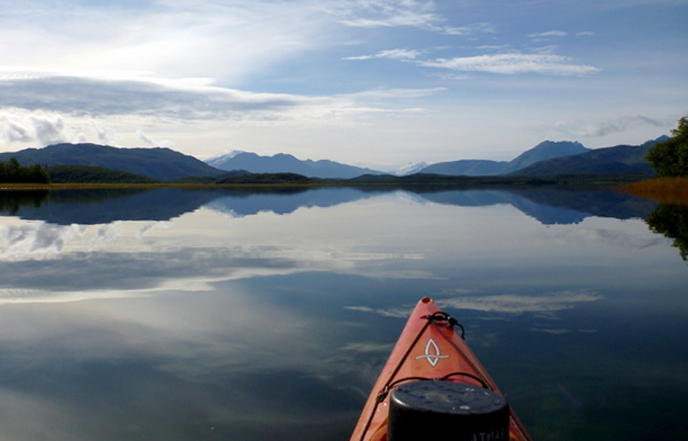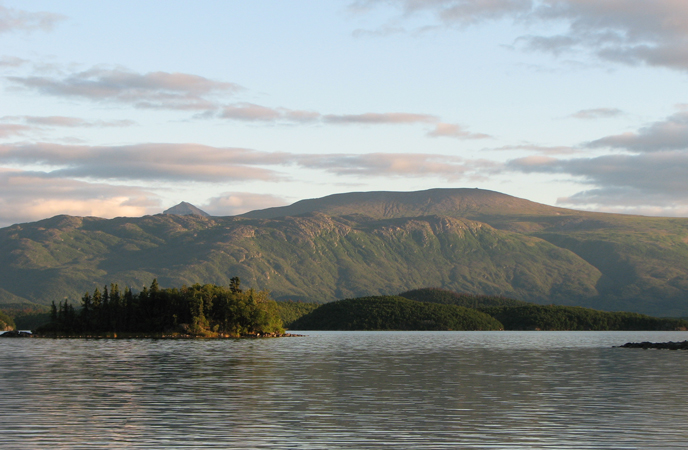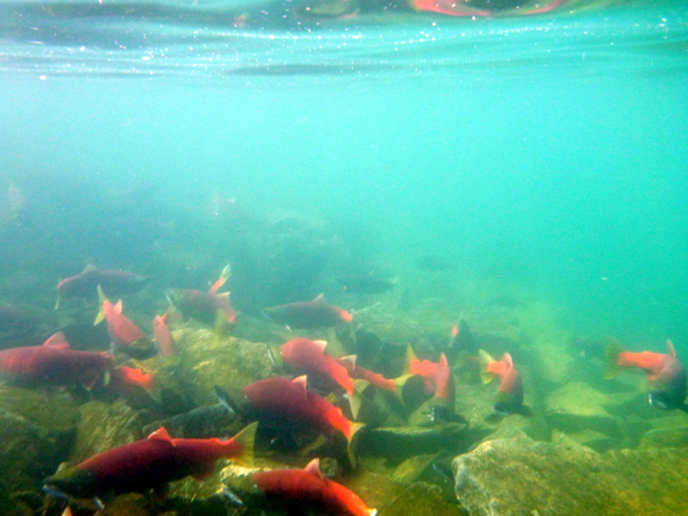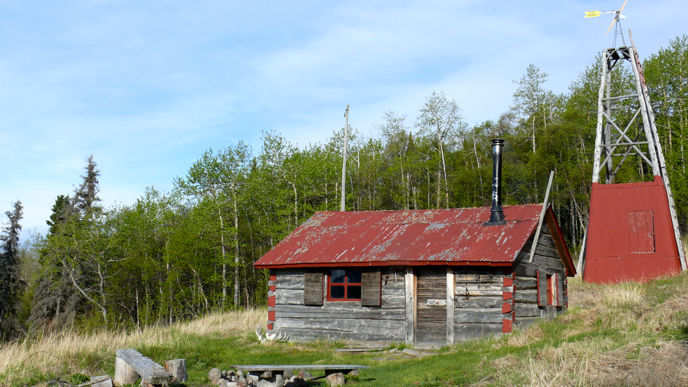
NPS/L. Ehler
Within the vast fresh water lakes of Katmai National Park and Preserve lie a hidden gem known as the Bay of Islands. Here nestled within the furthest reaches of the north arm of Naknek Lake, a one to hour motorized boat ride from Brooks Camp, stretches a happy geological accident of numerous granitic islands. These mostly unnamed islands jut out of the dark waters as deeply forested mounds, calling to mind the renowned coast line of Maine. As I glide my kayak through the tangled channels separating the mounds, which appear at a distance like green bristling mole hills, I can almost picture the long receded glaciers that carved these rock formations into the pleasing rounded shapes before me.
I paddle over to a lone rock standing guard in the middle of one passageway, and am rewarded by passing my hand along a striation carved patiently over the surface of the granite. This thin series of lines serve as a subtle reminder of the great quantities of ice that passed over this land 10,000 to 14,000 years ago. As I run my eyes up and over the rock following the carved grooves my eyes reach the still glaciated volcanic peaks in the distance. I guess this is the closest to a smoking gun one can find in glacier geology! As global temperatures fluctuate eventually ice may issue forth from these same peaks to embrace the Bay of Islands yet again.

Granite outcrops stand like mole hill in Bay of Islands on Naknek Lake. NPS/M. Fitz
The calm cool waters of the bay have served as an attraction for many wild residents, from those of the two to four legged variety especially. Animal trails are gently worn through the mosses below the encompassing spruce forests, suggesting the quiet footsteps of lynx and bear. My second morning of the trip was greeted with the long echo of a lone wolf calling along the shoreline to my right. Below the dark water the long snouts of northern pike, predatory fish, patrol the aquatic plants.
On my second afternoon, I pursued a personal lark to set up a hammock on a small island in the Bay. As I approached the leeward side of a small “mole hill,” my impulse was rewarded with innumerable bright red sockeye salmon resting among the ragged boulders below the surface. I decided to abandon my plans for a restful sit, and paddled the shoreline, one hand on my paddle, the other holding my submersible camera below the surface.

Bright red sockeye salmon also inhabit the quiet waters of Bay of Islands. NPS/L. Ehler
What were these fish doing here? Their bright red bodies and green heads spoke to the fact that the biological clock of these animals was about out of time; their bodies were primed for the last physical act of their lives, to propagate and die. Sockeye salmon, like their cousins rainbow trout or king salmon, need flowing water to bring oxygen to their eggs nestled among gravel. In fact the depth, silt, and rate of water flow have to be all within a narrow range of measurements for the eggs to hatch successfully! So what was the plan of these fish? There must be a stream nearby that I did not know of, for both genders were present. Usually the females will defend their collection of three to four nests, called a “redd”, from other females until they die. Males will usually fertilize the eggs and float downstream to congregate until death. I eventually expressed my good wishes to these migrants, and paddled back to my home for the night, Fure's Cabin.

Fure's Cabin in Bay of Islands offers a chance to find the solitude that former park residents experienced. NPS Photo
Roy Fure, an immigrant from Lithuania, built his eponymous cabin in 1926 to take advantage of the wildlife around the Bay of Islands. His winter days were spent harvesting the pelts of beaver, wolf, lynx, and any other commercially viable fur, and his winter nights were spent listening to his ingenious radio, powered by the windmill he erected behind his home. Something of a connoisseur of back country cabins, I find Roy Fure's handiwork to be one of my favorites in the country. Stout spruce logs have been hewn into rectangles, which are fit together expertly with dovetailed joints. The effect is substantial, an homage to the architecture of his Baltic homeland. Eventually Mr. Fure moved on to Portland, OR, but not before recording decades worth of his observations in his journals.
Today the cabin serves as a place of refuge for modern travelers, a rustic shelter in a unique corner of the Alaska Peninsula. The animals are no longer hunted, their habitat having long been added to the national park, and their tracks and other signs among the ancient stony isles are part of the magic of the Bay of Islands for the intrepid traveler. What better place for a solitary kayak journey, followed by recording one's own observations from the windows of Fure's Cabin?
For more information on traveling to this special place, please visit Katmai's Fure's Cabin page.
